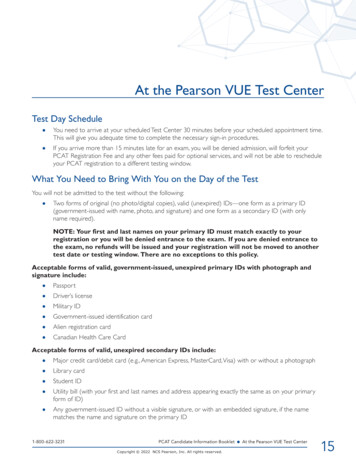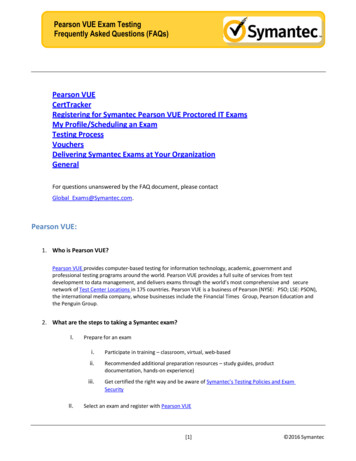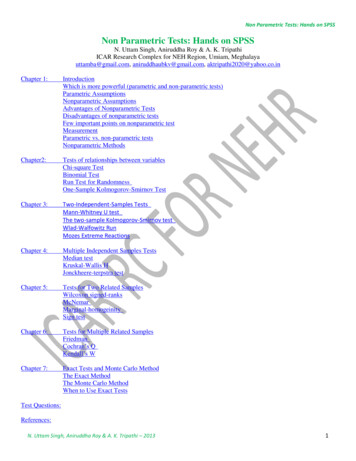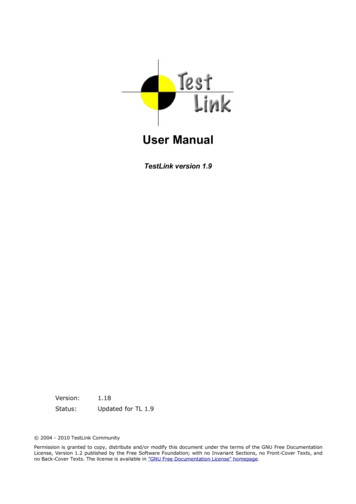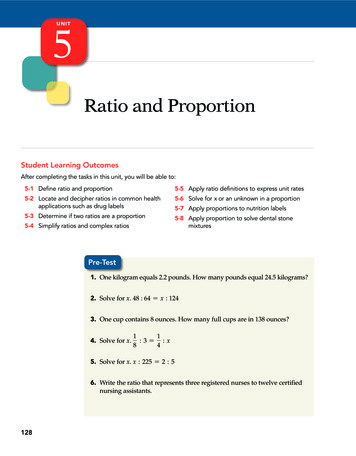
Transcription
UNIT5Ratio and ProportionStudent Learning OutcomesAfter completing the tasks in this unit, you will be able to:5-1 Define ratio and proportion5-5 Apply ratio definitions to express unit rates5-2 Locate and decipher ratios in common healthapplications such as drug labels5-6 Solve for x or an unknown in a proportion5-3 Determine if two ratios are a proportion5-8 Apply proportion to solve dental stonemixtures5-4 Simplify ratios and complex ratios5-7 Apply proportions to nutrition labelsPre-Test1. One kilogram equals 2.2 pounds. How many pounds equal 24.5 kilo grams?2. Solve for x. 48 : 64 x : 1243. One cup contains 8 ounces. How many full cups are in 138 ounces?4. Solve for x.11:3 :x845. Solve for x. x : 225 2 : 56. Write the ratio that represents three registered nurses to twelve certifiednursing assistants.128
UNIT 5 Ratio and Proportion 1297. The patient’s pulse is documented as 73 beats per minute. How manybeats will be documented for 5 minutes if the rate remains the same?8. Two tablespoons of peanut butter are used for each sandwich. Onetablespoon has three teaspoons. If 49 sandwiches are made, how manyteaspoons of peanut butter are needed to make these sandwiches?9. Write the medication dosage for the amount on this label. Write it as aratio. Include the unit of measure.1.* Each teaspoonful (5 mL) contains hydroxyzinepamoate equivalent to 25 mg hydroxyzinehydrochloride.USUAL DAILY DOSAGE:Adults: 1 to 4 teaspoonfuls 3-4 times daily.Children: 6 years and over– 2 to 4 teaspoonfuls dailyin divided doses. Under 6 years–2 teaspoonfuls dailyin divided doses.READ ACCOMPANYING PROFESSIONAL INFORMATION.PROTECT FROM MOISTURE AND HUMIDITY.Store below 77 F (25 C)SHAKE VIGOROUSLY UNTIL PRODUCT IS COMPLETELYRESUSPENDED.DYE FREE FORMULA1202.mLORAL SUSPENSION25 mg/5 mL*For Oral Use OnlyRx only120 ml NDC 55-32-6Practice Label110. The tapioca recipe calls for 2 cups of milk to make six servings. How2many cups of milk are needed for 15 servings?11. The dietitian ordered 4 ounces of chicken per patient for a dinner meal.The kitchen served 496 ounces of chicken this evening. How many patientsreceived a 4-ounce portion of chicken?12. The patient went to the laboratory to have blood drawn by a phlebotomist.Each tube of blood holds 2.5 milliliters of blood. Four tubes of blood weredrawn. How many milliliters of blood were drawn?13. On average, one registered nurse at Valley View uses 62 gloves a day toexamine patients. In 5 days, how many gloves will that particular nurseuse?14. Solve for x.4: 15 :: x : 207515. How many minutes are in 320 seconds? Your answer should be in minutesand seconds.
130 UNIT 5 Ratio and ProportionOverviewRatio is a way to show a relationship between two items. We are always countingand comparing items in our daily lives: hours at work versus hours away fromwork, number of yogurts we have eaten versus the number of yogurts still inthe refrigerator, and so on. Ratios simply help us compare two items, objects, oramounts.Proportion compares two equal ratios in a mathematical equation. We useproportion to either increase or decrease one part of the ratio in the equation so thatthe unit expressed or found is in the same relationship with the other part of thespecific ratio and so that this ratio, when completed, shows the same relationshipas the other ratio.RatioSET-UP HINTWriting yourratios in theproper orderis important.Follow the orderof each numberof the ratio inthe sentence orproblem. It isa good idea toinclude the units.In that way, youcan be sure thatyou have followedthe same patternin each ratio.REVIEWA ratio is used to show a relationship between two numbers or a comparison oftwo items. The numbers are separated by a colon (:) as in x : y. For example, threenurses and four medical assistants working a clinic shift can form a ratio. Ratiosmay be presented in three formats that provide the set-up for solving proportions.a. 3 : 4 (three nurses to four medical assistants)b.3(three nurses to four medical assistants)4c. 3 is to 4 (three nurses to four medical assistants)The relationship can represent something as simple as the 1 : 3 ratio commonly usedto mix frozen juices. We use one can of frozen juice concentrate to three cans ofwater. Ratios are fractions that represent a part-to-whole relationship. Often whenwe work with ratios, we use the fraction format to reduce the ratio to its simplestform.Ratios are always reduced to their lowest form. For example, 8 hours of sleepto 24 hours in a day would be expressed as8 : 24 S88 * 11 248 * 33so the ratio is 1 : 3.Practice 1Write the following relationships as ratios using a colon. Reduce to lowest terms, ifnecessary.1. 6 days out of 7 days2. twelve teeth out of thirty-two teeth
UNIT 5 Ratio and Proportion 1313. 8 students out of 15 students4. 16 scalpels to 45 syringes5. 7 inlays to 14 crownsSimplifying ratios is an important skill. To simplify a ratio, divide the firstnumber by the second.1For example, simplify the following ratio: 4 : 6.241969193 * 33 which becomes 3 : 4S, 6S , S * , as a simplified ratio22126123 * 44The answer is 3 : 4.1As another example, simplify the following ratio: 11 . Convert the mixed4number into an improper fraction, and then reduce, if necessary.14511 S 11 * 4 1 45 S 45 : 444The answer is 45 : 4.Practice 2Simplify the following ratios. Write each answer as a ratio.1. 24 : 32.7: 14 83. 25 :4.5 61: 45 35. 0.8 :6.1 42 51 1: 2 817. 4 : 7 3
132 UNIT 5 Ratio and Proportion8. 0.875 :1 29. 210.1 42: 0.33 3Ratios in Health CareDrug labels are another place that ratios may be seen in health care. Careful readingof the drug label will help locate the dosage of medication per tablet or per amountof solution. Notice that each label uses a specific language indicating a ratio. Theseformats are milligrams/milliliters (mg/mL), micrograms/milligrams (mcg/mg),mg per tablet, milligrams in milliliters (mg in mL), etc. Careful reading will helpidentify what is in each tablet, each milliliter of medication, etc.NDC 6077-112-81lorazepamEach milliliter contains4 milligrams of lorazepam.4 mg/mL 1mL Vial462-145-00For IM USE REFRIGERATE FORIV ROUTE, SEE DIRECTIONS.For IV use, additional dilutionis required; see accompanyinginformation. Usual Dosage: Seeaccompanying information. Donot use if solution is discoloredor contains a precipitate.PROTECT FROM LIGHTLot:Exp.:PLPharmaceuticalsPractice LabelPractice 3Read the labels and write the ratio of the medication indicated in each label. Write the ratioin simplified form.Exp. DateLot.For intravenous for subcutaneous useMultiple Dose VialPractice LabelRx only354588–23For educational Purposes OnlyStore at 25 C (77 F);excursions permitted to 15 to 30 C(59 to 86 F).10,000 units/mLDerived from porcine intestinal mucosaUse only if solution is clearand seal is intact.heparin sodiumInjection, USPSterile, nonpyrogenicEach mL contains: 1000 USP unitsheparin sodium: 9 mg sodiumchloride; 0.15% methylparaben;0.015% propylparaben; water forinjection q.s. Made isotonic withsodium chloride. Hydrochloric acidand/or sodium hydroxide may havebeen added for pH adjustment.NDC 0025-6589-82PLPharmaceuticals1.
UNIT 5 Ratio and Proportion 1332.NDC 0641-0180-25Each mL contains morphine sulfate10 mg. sodium dihydrogen phosphate10 mg. disodium hydrogen phosphate2.8 mg. sodium formaldehyde sulfoxylate 3 mg and phenol 2.5 mg in Waterfor Injection. Sulfuric acid used to adjustpH to 2.5–6.0. Sealed under nitrogen.morphineSulfateInjection, USPFOR SUBCUTANEOUS, INTRAMUSCULAR ORSLOW INTRAVENOUS USEUsual Dose: See package insert forcomplete prescribing information.NOT FOR EPIDURAL OR INTRATHECAL USEWARNING: May be habit formingNote: Slight discoloration will not alterefficacy. Discard if markedly discolored.PROTECT FROM LIGHTDO NOT USE IF PRECIPITATEDCaution: Federal law prohibits dispensingwithout prescription.Rx only10 mg/mL1 mL VialPLPharmaceuticalsPractice Label3.Each 5 mL contains 125 mg cefdinir after reconstitution.DIRECTIONS FOR RECONSTITUTIONPrepare suspension at time of dispensing by adding a total of 63 mL water to the bottle. Tap bottleto loosen the powder, then add about half the water, and shake. Add the remaining water andshake to complete suspension. This provides 100 mL of suspension.100 mLORAL SUSPENSION125 mg per 5 mLSHAKE WELL BEFORE USING.Keep bottle tightly closed.Any unused portion mustbe discarded 10 daysafter mixing.USUAL DOSAGE: Children-14 mg/kg/day in a single dose or in two divided doses, dependingon age, weight, and type of infection. See package enclosure for full prescribing information.This bottle contains 2.5 g cefdinir. Do not accept if seal over bottle opening is broken or missing.Keep this and all drugs out of the reach of children. Store dry powder and reconstitutedsuspension at 25 C (77 F); excursions permitted to 15 –30 C (59 –86 F) [see USPControlled Room Temperature]. Use within 10 days. SHAKE WELL BEFORE EACH USE.Keep bottle tightly closed.RECONSTITUTE WITH63 mL WATER029158(when reconstituted)100 mL NDC tExpiration date of powder.Rx onlyPractice Label4.Store at 25 ºC (77 ºF)Delivers 5 mLEach 5 mL contains:8 mEq of Lithium lon(Equivalent to 300 mg ofLithium Carbonate per 5 mL)Alcohol 0.3%LITHIUMCitrate Syrup, USP8 mEq/5 mLNDC 68094-767-59Sugar-Free768 RO6498Rx onlyPLPharmaceuticalsPractice Label5.NDC 1123-4567-89lincomycin hydrochloride300 mg/mL10 mLmultidose vialPLPharmaceuticalsPractice Label
134 UNIT 5 Ratio and ProportionUnit RatesAnother example of ratio in health care comes from dealing with insurance coverage. There is something called a medical loss ratio, which is used in managed careto measure medical costs as a percentage of premium revenues or income. It is atype of loss ratio used to measure the percentage of premiums paid out in claimsrather than expenses. A desirable ratio is 17 : 20 or 85% or less.In addition, ratios can compare two items. For example, ratios are often usedto find the unit rate, which is a rate having 1 as its denominator. Rate is a ratio oftwo measurements having different units.Example : 4.10 (a package of gauze strips)24 (individual number of strips)To get the unit rate, divide the bottom number (the denominator) into the topnumber (the numerator). 4.10 , 24 0.170833 or 17 cents per sheet of gauze17 cents : 1 sheet or 17 : 1Practice 4Express each as a unit rate.1.2.3.4.5. 4182 room bill for a hospital stay3 days in the hospital120 pound goal to lose52 weeks in a year24 ounces3 cups14 cups of sugar252 cookies14235 patients365 daysProportionREVIEWProportions can be applied to almost every health care profession in one way oranother. In addition to on-the-job applications, proportions provide a simple andquick method for solving many everyday math problems such as measurementconversions, recipe conversions for increasing or decreasing the amounts of ingredients, and map mileage.
UNIT 5 Ratio and Proportion 135Proportions are two or more equivalent ratios or fractions in which the termsof the first ratio/fraction have the same part-to-whole relationship as the secondratio/fraction.Example1If one box of gloves contains 100 gloves, then 4 boxes will contain how many2gloves?14 boxes11 box24 4.5 S 4.5 * 100 450 100 glovesx number of gloves 2Once you become well versed in the set-up, you may drop the units.However, labeling the units is very helpful to ensure the proper set-up.SET-UP HINTNotice how theterms for eachcategory (boxesand gloves) areacross from eachother. This is theproper set-up:boxes acrossfrom boxes andgloves across fromgloves.315 or 3 : 4 :: 15 : 20420Test the two ratios/fractions to see whether they are equivalent by multiplyingdiagonally (cross multiply).315 4 * 15 60 and 3 * 20 60. This is a proportion.420If the two numbers that are diagonal result in the same answer when they aremultiplied, you are working with a proportion.Proportions are powerful tools in health care. You can rely on them for solvinga majority of your math conversions and problems.Practice 5Check to see if the following ratios are proportions.1. 5 : 2 4 : 1YesNo2. 16 : 15 8 : 7YesNo3. 40 : 30 4 : 3YesNo4. 10 : 16 5 : 8YesNo5. 100 : 1 50 : 2YesNoSolving for xREVIEWThe ratio and proportion method is used to solve for x. Solving for x uses the knownor given information to find what is not known or given. Since a proportion consists of two equal ratios, the relationship between the numerator and denominatorMATH SENSE: : means “is” or
136 UNIT 5 Ratio and Proportionof each fraction is the same for each ratio of the proportion. This is important toknow when one must increase or decrease a solution or mixture because the ratioof ingredients must remain constant.Solving for x is done in two steps.STEP 1: Set the problems up like fractions. If units of measure such as inchesand feet are given, place inches across from inches and feet across fromfeet. Then cross multiply (diagonally) the two numbers. Set the ratiosup like fractions using a vertical line.3? 4163 * 16 48STEP 2: Divide the answer from step 1 by the remaining number.124) 48-4T8-80The quotient 12 is the answer to ? or x. This method is an easy way to find theanswers for measurement conversions, dosage conversions, and math questionsthat provide part but not all of the information.Practice 6Solve for x or ?1. 12 : 45 x : 152. x : 6 15 : 603. 25 : 45 75 : x4. 7 : x 21 : 245. 3 : 9 ? : 816. 13 : 39 1 : ?7. 2 : 11 ? : 778. x : 125 5 : 259. 2 : 26 4 : ?10. 1 : x 5 : 200
UNIT 5 Ratio and Proportion 137Using ratios is often the simplest method of solving other health care mathproblems, such as dosage calculations and measurement problems.ExampleZoe weighs 35 pounds. Her doctor prescribed a drug that relates milligrams ofmedication to kilograms of body weight. The pharmacy technician will needto convert pounds to kilograms. By using the ratio of 1 kilogram to 2.2 pounds,the answer is quickly computed.known1 kilogram2.2 pounds unknown? kilograms35 poundsSTEP 1: Multiply the numbers diagonally.1 * 35 35STEP 2: Divide 35 by 2.2. The answer is 15.9 kilograms.So, 35 pounds equals 15.9 kilograms.Converting between kilograms and pounds is a common procedure in health care.Practice 7Set up and solve these conversions using ratio and proportions. Round to the nearest tenth,if necessary. Use the conversion 1 kilogram 2.2 pounds.1. Convert 16.4 kilograms to pounds.2. Convert 125.8 kilograms to pounds.3. Convert 35 kilograms to pounds.4. Convert 75 kilograms to pounds.5. Convert 83.5 kilograms to pounds.6. Convert 16 pounds to kilograms.17. Convert 25 pounds to kilograms.28. Convert 108 pounds to kilograms.9. Convert 215.6 pounds to kilograms.10. Convert 165 pounds to kilograms.
138 UNIT 5 Ratio and ProportionExampleHow many pounds are in 24 ounces?Set the problem up by placing what you know on the left side of theequation and what you do not know on the right side. If you set up all yourproblems with the known on the left and the unknown on the right, therewill be less information for your brain to process because the pattern will befamiliar to you.known1 pound16 ounces unknown? pounds24 ouncesSTEP 1: 1 * 24 24STEP 2: 24 , 16 1.51The answer is 1 pounds or 1.5 pounds.2The answer in a ratio may have a decimal or a fraction in it.ExampleBob is 176 centimeters (cm) tall. How tall is he in inches? Round the answer tothe nearest tenth.knownunknown? inches1 inch 2.54 cm176 cmSTEP 1: 1 * 176 176STEP 2: 176 , 2.54 69.2969.29254) 17600- 1524T2360- 2286 T740- 508 T2320- 228634So, after the division: 176 , 2.54 69.29. Rounded to the nearest tenth,the answer is 69.3 inches.Notice that the units in the metric system are often rounded to the nearesttenth. This is why the division problem above adds a decimal and zeros: towork out the dividend to the hundredths place so that the final answer isrounded to the tenth.
UNIT 5 Ratio and Proportion 139SET-UP HINTSome basic guidelines need to be followed when formatting answers in measurementconversions:If the answer is in feet, yards, cups, pints, quarts, gallons, teaspoons, tablespoons,or pounds, use fractions if there is a remainder.If the answer is in kilograms, milliliters, or money amounts, use decimals. Thecorrect format ensures correct answers, which are often rounded to either the tenth orthe hundredth place.APPROXIMATE EQUIVALENTS1 inch 2.54 centimeters1 cup 8 ounces1 foot 12 inches1 pint 480 milliliters*1 yard 3 feet1 quart 32 ounces1 pound 16 ounces1 quart 960 milliliters*1 kilogram 2.2 pounds1 pint 2 cups1 tablespoon 3 teaspoons1 fluid ounce 30 milliliters1 quart 2 pints1 teaspoon1 gallon 4 quarts1 fluid ounce 2 tablespoons 5 milliliters*Certain fields use rounded measures; for example, instead of 480 mL and 960 mL, they use 500 mL and1000 mL. Check with your instructor.Notice that the conversions are set up so that the unit (1) elements are all on the leftand that these will be placed on the top of the known part of the ratio and proportion equation. This simplifies the learning process, expedites learning, and helpsrecall of these conversions.Practice 8Using the ratio and proportion set-up below, solve the following conversions.knownunknown Set up these conversions using ratios and proportions.1. 23 feet 2. 18 quarts yards S1 yd3 ftgallons3. 3 quarts pints14. 2 pints 4cups ?23 ftSET-UP HINTBecause inchesare roundedto the nearesttenth, go to thehundredthsplace and stopdividing. At thatpoint, you willhave enoughinformation toround to thenearest tenth.
140 UNIT 5 Ratio and Proportion5. 3 tablespoons 16. 2 quarts 27.1cup 2teaspoonsmillilitersounces8. 1 injection at 29.50 3 injections at19. 3 pounds 2ounces10. 3 medicine cups milliliters(One medicine cup equals 1 fluid ounce.)11. 12.5 mL teaspoons12. 5 fluid ounces 13.tablespoonstablespoons 15 teaspoons14. 64 ounces cups15. 750 milliliters pints16. 48 inches feet17. 5 pounds ounces18.quarts 5000 milliliters19.kilograms 11 pounds20. 15 cups ouncesUsing Proportions and Metric Units to Measure DentalStoneSometimes dental assistants need to mix dental stone material for dental molds.The amount of stone and water varies according to the size of the mold needed.A dental assistant learns the importance of mixing a uniform and consistent material for the mold. This task uses the metric system: Dental stone is measured byweight in grams, and room temperature water is measured by volume in milliliters.Knowledge of the metric system coupled with the use of ratio and proportion helpmaintain the correct ratio of dental stone to water.
UNIT 5 Ratio and Proportion 141100 mL80 mL60 mL40 mL20 mLThe typical ratio of dental stone to water is:263 grams of dental stone powder80 milliliters of room temperature waterDental assistants use this ratio as the standard to solve variances in either stoneor water to create the proper amount of material for the mold. On occasion, theymay be asked to use other ratios of dental stone to water, depending on the type ofmaterial or the mold being created.ExampleWe will set up the problems as proportions, cross multiply, and then divide bythe leftover number. This will solve for the unknown.If the dentist requests a smaller mold using 35 mL of water, how much stoneshould be used?The set-up is:263 g80 mL ?g35 mLSTEP 1: 263 * 35 9205STEP 2: 9205 , 80 115.0625. Round to the nearest whole number.The final answer is that 115 grams of stone to 35 milliliters of water should be used.Practice 9Solve the following using this ratio:263 grams dental stone powder80 milliliters of waterRound to the nearest whole number.1. If you use 75 grams of stone, how many milliliters of room temperature waterare needed?
142 UNIT 5 Ratio and Proportion2. If you use 125 milliliters of water, how many grams of dental stone areneeded?3. If you use 95 grams of stone, how many milliliters of room temperaturewater are needed?4. If you use 75 milliliters of water, how many grams of dental stone areneeded?5. If you use 65 grams of stone, how many milliliters of room temperaturewater are needed?6. If you use 55 grams of stone, how many milliliters of room temperaturewater are needed?7. If you use 40 milliliters of water, how many grams of dental stone areneeded?8. If you use 35 grams of stone, how many milliliters of room temperaturewater are needed?9. If you use 50 grams of stone, how many milliliters of room temperaturewater are needed?10. If you use 60 milliliters of water, how many grams of dental stone areneeded?Word Problems Using ProportionsREVIEWWhen solving word problems involving proportions, follow these three basic steps.
UNIT 5 Ratio and Proportion 143ExampleIf 12 eggs cost 1.49, how much do 18 eggs cost?Eggs S 12 eggs18 eggs CostCost S 1.49 ?EggsSTEP 1: Set the problem up so that the same types of elements are directlyacross from one another.STEP 2: Multiply the diagonal numbers. 1.49 * 18 26.82STEP 3: Divide the answer from step 2 by the remaining number in theproblem.26.82 , 12 2.235 or 2.24So, 18 eggs cost 2.24.ExampleHow many milligrams of medication would a nurse administer to a 95-poundchild if the prescribed dose was 30 milligrams for every 10 pounds?STEP 1: 30 milligrams x milligrams10 pounds95 poundsSTEP 2: 30 * 95 2850STEP 3: 2850 , 10 285 milligramsSo, the child would receive 285 milligrams of the medication.ExampleThe lab mixes a 12% solution for the physician. A 12% solution has a 3 : 25 ratio.This ratio includes 3 grams of powder in 25 milliliters of solution. How manygrams of powder will be added to 65 milliliters of solution?STEP 1:3 grams25 millilitersSTEP 2:3 * 65 195STEP 3:195 , 25 7.8 grams x grams65 millilitersSo, 7.8 grams of powder will be used to mix 65 milliliters of the 3 : 25 solution.SET-UP HINTEnsure that youunderstand thestory problem,and then placethe knowninformation onthe left side ofthe proportionand the unknowninformation on theright. By doingso, you will notswitch the ratiorelationships, butinstead will relyon the knownpart-to-wholerelationships.
144 UNIT 5 Ratio and ProportionPractice 10Solve the following word problems.1. A caplet contains 325 milligrams of medication. How many caplets contain975 milligrams of medication?2. If a dose of 100 milligrams is contained in 4 milliliters, how many millilitersare in 40 milligrams?3. If 35 grams of a pure drug are contained in 150 milliliters, how many gramsare contained in 75 milliliters?4. Three tablets of ulcer medication contain 375 milligrams of medication. Howmany milligrams are in 12 tablets?5. If 1 kilogram equals 2.2 pounds, how many kilograms are in 61.6 pounds?Solving for x in More Complex Problems UsingProportionREVIEWDecimals and fractions may appear in your proportion problems. Although thenumbers may be visually distracting, the very same principles apply when solvingthese proportions.Example0.25 mg : 0.8 mL 0.125 mg : x mLSTEP 1: Place mg across from mg and mL across from mL. Place the knowninformation on the left side of the equation and the unknown information on the right side.knownunknown0.125 mg0.25 mg 0.8 mLx mLCross multiply 0.8 * 0.125 mg 0.1.STEP 2: 0.1 , 0.25 0.4 mL
UNIT 5 Ratio and Proportion 145Example1 1: :: 1 : x8 2181 x12STEP 1: Set up and cross multiply. MultiplySTEP 2: Divide11* 1 .2211by .2811188, S * , which is reduced to 4.28212Sometimes you will find that medical dosages have both fractions anddecimals. Analyze the situation and convert the numbers to the same systemformat. As a general rule, fractions are always more accurate for calculatingthan decimals because some decimal numbers have repeating digits, whichcreate variable answers.Example11: 1.6 :: : x168This looks like this as a fraction:11168 x6110STEP 1: Convert 1.6 into a fraction. So, 1.6 111168 x6110STEP 2: Divide16612. Then multiply 1* .101081061161162* * or108108801021by .1016212163221S,* . Reduced to 3 S 3 .101610110105
146 UNIT 5 Ratio and ProportionSET-UP HINTTablets can bedivided if they1are scored; use ,2not 0.5.Practice 11Include a unit of measure in your answer. Round any partial unit to the nearest tenth.1. 2.5 mg : 2 mL 4.5 mg : x mL2. 12 mg : 2.5 mL 4 mg : x mL3. 7.5 mg : 5 mL 24 mg : x mL4. 0.2 mg : 1 tab 6 mg : x tabs5.1grains : 15 mg ? grains : 60 mg46. x mg :7.1tab 6 mg : 4 tabs211grains : 2 mL grains : x mL1001508. 600 mg : 1 cap x mg : 2 caps9. 1000 units : 1 mL 2400 units : x mL10. 1 tab : 0.1 mg x tabs : 0.15 mg11. A drug comes in 100 milligram tablets. If the doctor orders 150 milligramsdaily, how many tablets should the patient receive daily?12. A medical chart states that the patient weighs 78.4 kilograms. What is thepatient’s weight in pounds? Round to the nearest tenth.Nutritional Application of ProportionsREVIEWCarbohydrates, fats, and proteins provide fuel factors for our bodies. These factorsare easily applied by using proportions to solve for the unknown.SET-UP HINTCarbohydrates S 4 calories per 1 gramFatsS 9 calories per 1 gramProteinsS 4 calories per 1 gram
UNIT 5 Ratio and Proportion 147Example400 carbohydrate calories gramsknown1 gram4 calories unknown? grams400 caloriesSTEP 1: Multiply diagonally.1 * 400 400STEP 2: Divide answer from step 1 (400) by the remaining number in the equation (4).1004) 400-400So, 400 carbohydrate calories are available in 100 grams of carbohydrates.Practice 12Use proportion to solve the following problems.1. 81 calories of fat 2. 120 calories of protein gramsgrams3. 36 calories of carbohydrate 4. 145 calories of carbohydrate gramsgrams5.calories are in 12 grams of protein.6.calories are in 99 grams of fat.7.calories are in 328 grams of carbohydrate.8.calories are in 2450 grams of protein.Proportion is also useful in solving nutritional problems that involve amounts ofsodium, calories, fat, and protein in food or an amount in a drug dosage. The proportion will use the information in a scenario to solve for the unknown quantitiesof a specific amount.
148 UNIT 5 Ratio and ProportionExampleIf one glass of milk contains 280 milligrams of calcium, how much calcium is in11 glasses of milk?211 glasses1 glass2 280 milligrams? milligrams280 * 11 420 mg of calcium2Practice 13Solve these nutritional problems using ratio and proportion.1. One-half cup of baked beans contains 430 milligrams of sodium. How many3milligrams of sodium are there in cup of baked beans?412. Baked beans contain 33 grams of carbohydrates in a cup serving. How21many milligrams of carbohydrates are in three cup servings?21cup serving of fruit cocktail contains 55 milligrams of potassium. How2many milligrams of potassium are in 2 cups of fruit cocktail?3. A11cup of fruit cocktail contains 13 grams of sugar, then 1 cup of fruit24cocktail contains how many grams of sugar?4. If15. Old-fashioned oatmeal contains 27 grams of carbohydrates per cup of dry21oats. How many grams of carbohydrates are available in 2 cups of the dry4oats?Practice with Food LabelsKnowing how to read food labels is important because patients often need to limittheir salt, sugar, and fat intake to help ensure good health. Proportion is usefulin figuring out the amounts of these ingredients when portioning—increasing ordecreasing portions.
UNIT 5 Ratio and Proportion 149Practice 14Carefully read the label and then use its information to solve each question.Albert’s Tomato SoupNutrition factsAmount/serving %DV*Amount/serving %DV*Serving size ½ cup (120 mL)Condensed soupServings about 2.5Calories 90Fat calories 0Total fat 0 g0% Total carbohydrates 20 g 7%Saturated fat 0 g 0% Fiber 1 g4%Cholesterol 0 mg 0% Sugars 15 gSodium 710 mg 30% Protein 2 gVitamin A 12% Vitamin C 12% Calcium 0% Iron 0%*Percent daily values (%DV) are based on a 2000 calorie diet.1cup of soup equals 120 milliliters, then how many milliliters (mL) are in213 cups of soup?31. If2. If a can has 2.5 servings, how many cans are needed to serve 10 people?13. One serving contains 90 calories; how many calories are in 4 servings?24. One gram of fiber constitutes 4% of a daily dietary value. How many gramsof fiber would be present in 25% of the daily value?5. How many grams of carbohydrates are present if the portion meets 15% ofthe daily value of carbohydrates? Round to the nearest tenth.Use the information from the label to complete these proportions.Big Al’s Organic Sweet and Juicy Dried PlumsNutrition factsAmount per servingServing size 1½ oz (40 g in about 5 dried plums) Calories 100Calories from fat 0Servings per container about 30Total fat 0 g%DV*0%Saturated fat 0 g0%Cholesterol 0 mg0%Sodium 5 mg0%Vitamin A 10% (100% as beta carotene)Vitamin C0%Calcium2%Iron2%*PercentPotassium 290 mgTotal carbohydrates 24 gDietary fiber 3 gSoluble fiber 1 gInsoluble fiber 1 gSugars 12 gProtein 1 g%DV*8%8%11%Big Al’s Organic Sweet and JuicyDried Plums/Prunesdaily values (%DV) are based on a 2000 calorie diet. Your daily values may behigher or lower depending on your calorie needs.
150 UNIT 5 Ratio and Proportion6. How many total grams (g) of weight are present in 34 prunes?7. If 100 calories are consumed with 5 prunes, how many calories are consumedwith 12 prunes?8. If 5 prunes have 290 milligrams (mg) of potassium and that accounts for 8%of percent daily value, how many prunes are needed to equal 15% of thepercent daily value? Round to the nearest whole number.9. If 5 prunes provide 10% of the Vitamin A needed daily, what percent of thedaily percent of Vitamin A is present in 20 prunes?110. If a serving size is 1 ounces (oz), how many ounces are five servings?2Use the information from the label to complete these proportions.Jade’s Soy MilkNutrition factsServing size 1 cup (240 mL)Servings about 8 per 1.89 LCalories 80Fat calories 35Amount/serving %DV*Amount/serving %DV*Total fat 4 g6%Total Carbohydrates 4 g 1%Saturated f
nurses and four medical assistants working a clinic shift can form a ratio. Ratios may be presented in three formats that provide the set-up for solving proportions. a. 3 : 4 (three nurses to four medical assistants) b. 3 4 (three nurses to four medical assistants) c.the sentence or 3 is to 4 (three nurses to four medical assistants)





